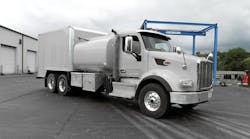Members of National Tank Truck Carriers Inc took a bold step for safety during their annual conference in New York City in May. They called on the Department of Transportation (DOT) to mandate roll stability technology on all new power units used to haul placarded hazardous materials loads.
NTTC would like DOT to propose a roll stability requirement for heavy-duty trucks before the end of 2008. DOT officials attending the NTTC annual conference said they would take the request under advisement but could make no promises.
Truth be told, DOT officials probably were very receptive toward the NTTC request. They just couldn't say anything official at the NTTC annual conference. DOT officials have said they are very concerned about rollover frequency. Department statistics indicate heavy-duty truck rollovers are occurring at a rate of about one a day. More than 1300 cargo tank rollovers are recorded annually.
NTTC and DOT have begun working closely on the cargo tank rollover side of the problem, and they are making progress. Together, they are developing training programs and public service campaigns to raise driver awareness of the threat posed by cargo tank rollovers. NTTC and DOT worked together on the very-successful Cargo Tank Rollover Prevention Summit meetings that were held in late 2007.
NTTC also is a participant in the seatbelt usage campaign launched in 2007 by the American Trucking Associations and DOT. Elements of the campaign included a lobbying effort to encourage primary seatbelt laws (which let law enforcement officials stop and cite drivers solely for not wearing a seatbelt) in all 50 states and an educational program for truck drivers.
A DOT survey shows that the campaign helped boost overall seatbelt use to 65% among drivers of medium-duty, Class 7, and Class 8 trucks. Seatbelt use reached 69% in the states that passed primary seatbelt laws.
The point to all of this is that safety always has been a focal point for the tank truck industry, and these latest efforts are taking that commitment to a higher level. Tank truck carriers have built an outstanding safety record that is the envy of the entire trucking industry.
These programs clearly are paying dividends. Three of the primary measures of large truck safety fell to record lows in 2006, according to the latest figures released by DOT. The report issued by DOT's Federal Motor Carrier Safety Administration shows that the large-truck involvement rate in fatal crashes, the fatality rate, and the fatal crash rate for large trucks each declined to the lowest level since DOT began gathering the statistics in 1975.
The 2006 fatal crash rate for large trucks stood at 1.93 fatal crashes per 100 million vehicle-miles-traveled. The large-truck involvement rate dropped to 2.12 per 100 million vehicle-miles-traveled, down from 2.21 the previous year. The fatality rate declined to 2.24, down from 2.34 in 2005.
Large trucks were involved in slightly under 5,000 motor vehicle traffic fatalities, which came to about 12% of total vehicle fatalities in 2006. Large trucks accounted for just 8% of all vehicles involved in fatal crashes and 4% of all vehicles involved in injury and property-damage-only crashes.
These are impressive statistics for the trucking industry. In comparison, motor vehicle traffic crashes of all kinds resulted in the deaths of 42,642 people. That's nearly as many deaths as were suffered by the US military during the Korean War. An average of 117 people died each day in 2006 in US motor vehicle crashes, or one every 12 minutes.
Those are sobering numbers. Compared with the motoring public in general, truck fleets operating in the United States have an outstanding safety record. The trucking industry truly is a leader in highway safety.
Tank truck carriers, and truck fleets in general, certainly deserve credit for their achievements in crash prevention. Still, they can't rest on their laurels. The only acceptable final objective must be zero motor vehicle fatalities.








